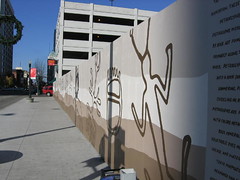Downtown Hole
 Example of Boise Hole wall project Photo by Kenneth Freeman, and used under a Creative Commons license.
Example of Boise Hole wall project Photo by Kenneth Freeman, and used under a Creative Commons license.
While enjoying downtown Boise on 8th and Main you will see a combination of new and old buildingss. The Boise National Bank building, currently under construction to become the 805 Main building, will use the old bank as a restaurant and commercial space while keeping some of its historical charm. An example of this charm will be the restoration of the bank’s vault doors. Across the street is a newer building connected to the Urban Renewal Project from the 1970's which currently houses the Balcony night club, and several restaurants on the second floor. If you choose to visit these second floor downtown hotspots, your view across the street will not be a beautiful historic building next to the Boise National Bank, but rather an empty hole. On ground level the hole is boarded off and painted frequently in murals and advertisements by the Boise Hole wall project. This eye sore has become Boise history as it celebrated its 24th Birthday as a hole in the downtown this last January! Word on the street always says that it is consistently tied in litigation. True or not here is a little history of the cursed hole in Boise thanks to the Idaho Statesman article by Cynthia Sewell in March 4th, 2011 edition:
Here's a recap of the site's infamous history:
The Curse of the Eastman Building (or how we got the Downtown hole)
In 1905, Hosea Eastman set out to build a hotel that would put the Idanha to shame. A hole was dug at the corner of 8th and Main to accommodate it, but the design was so expensive it was scrapped and an office building was built instead.
Designed by Tourtellotte and Hummel, the firm that designed the Statehouse and St. John's Cathedral, the structure featured 100 stone lion heads on a terra cotta cornice. It quickly became the most fashionable office space in town.
In 1972, the Boise Redevelopment Agency, Capital City Development Corporation's predecessor, acquired the property as part of the city's urban renewal project.
The redevelopment agency tried to raze the six-story building to make way for a shopping mall. A citizens group stopped the agency in court, arguing that Downtown deserved better, and the Eastman Building became a symbol of conflicting views over Downtown's future. The building sat vacant and dilapidated for almost a decade.
On Jan. 24, 1987 ‹ just two days after developers announced plans to renovate the historic building ‹ the Eastman Building burned under suspicious circumstances. It was the largest building in Boise destroyed by fire.
The gutted building had to be condemned and knocked down. Every lion head was partially shattered as it crashed to the pavement below. The half-acre lot has been vacant ever since.
A decade after the fire, the city's urban renewal agency gave the green light to developer Rick Peterson¹s plan to build the 25-story Boise Tower, which would have been Boise¹s tallest building. Peterson broke ground in 2001, and two years later, with only the foundation partially completed, the city revoked Peterson's building permit, citing a lack of progress. For the next six years, the property went through a slew of legal and financial battles, including a new owner and a couple of bankruptcies.
In 2009, Capps Holdings LLC, the parent company of Robert Capps Homes, a Lake Tahoe, Calif., development company, acquired the property at a foreclosure auction when no other bidders emerged. Capps has said he has no immediate plans for the property, which is for sale.


